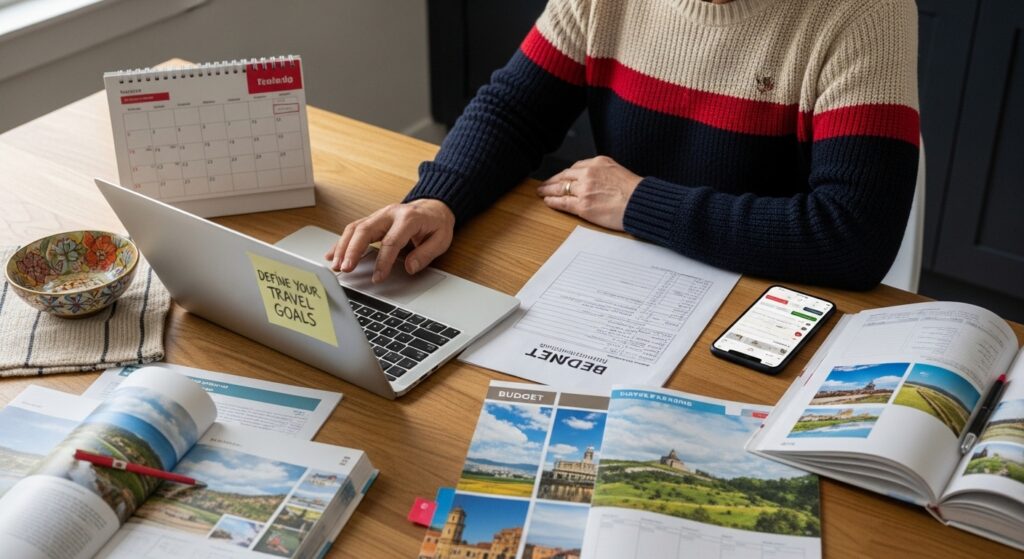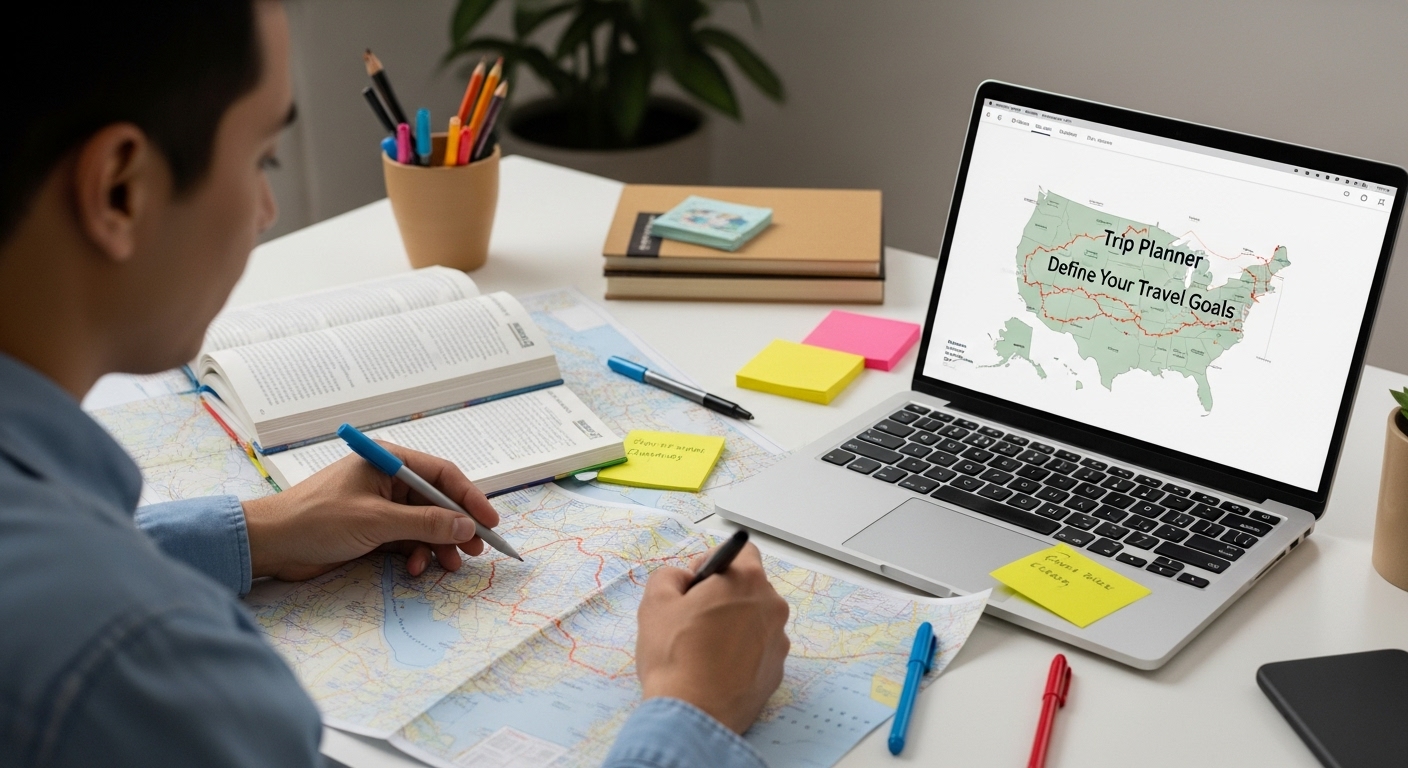Planning a trip sounds exciting and most people believe the hardest part is picking where to go. But research shows that defining clear goals and creating a realistic budget are actually the most important steps for successful travel. Set these foundations first and every other detail from destination to packing becomes easier than you thought.
Table of Contents
- Step 1: Define Your Travel Goals And Budget
- Step 2: Research Potential Destinations
- Step 3: Create An Itinerary With Activities And Accommodations
- Step 4: Book Transportation And Lodging
- Step 5: Prepare Essential Documents And Packing Lists
- Step 6: Finalize And Verify Your Travel Plans
Quick Summary
| Key Point | Explanation |
|---|---|
| 1. Define clear travel goals | Establish your travel purpose to guide decisions and budgeting. Consider relaxation, adventure, cultural exploration, or personal growth. |
| 2. Create a detailed budget | Break down expenses into categories like transportation, accommodations, and meals to manage finances effectively. |
| 3. Research health and safety | Investigate local conditions, healthcare availability, and safety advisories to prepare adequately for your destination. |
| 4. Organize essential documents | Prepare both digital and physical copies of critical travel documents, such as passports and insurance, to avoid last-minute issues. |
| 5. Finalize and confirm plans | Reconfirm all reservations 48-72 hours prior to travel. Verify that your itinerary is complete and that necessary arrangements are in place. |
Step 1: Define Your Travel Goals and Budget
Successful travel planning begins with crystal clear goals and a realistic budget. This foundational step transforms your travel dreams from vague wishes into an actionable roadmap. Understanding your travel objectives and financial constraints will guide every subsequent decision in your trip preparation.
Start by asking yourself critical questions about your travel purpose. Are you seeking relaxation, adventure, cultural exploration, or personal growth? Each goal demands a different approach to planning and budgeting. Personal travel motivation directly influences destination selection, duration, and overall trip expenses.
Financial preparation requires honest self assessment. According to University of Texas at Arlington, estimating anticipated expenses is crucial. Break down potential costs into categories like transportation, accommodations, food, activities, and emergency funds. Create a spreadsheet or use a travel budgeting app to track projected expenses, allowing flexibility for unexpected costs.
Consider your financial comfort zone realistically. Some travelers prefer luxury experiences, while others prioritize budget-friendly options. Determine your maximum comfortable spending limit and work backward, identifying destinations and experiences that align with your financial boundaries. Pro tip: Always include a 10-15% buffer in your budget for unexpected expenses or spontaneous opportunities.
Research destination costs thoroughly. Different locations have dramatically varying expense levels. Southeast Asian countries might offer budget-friendly experiences, while European destinations could require more substantial financial investment. Use online travel forums, budget tracking websites, and destination-specific cost guides to refine your financial expectations.
Verify your travel goal completion by checking these key indicators:
- Clear understanding of travel purpose
- Comprehensive budget spreadsheet
- Identified potential destinations matching goals
- Emergency fund allocation
- Realistic expense projections
Remember, defining goals and budget isn’t about limitation—it’s about creating a framework that transforms your travel dreams into achievable, enjoyable experiences.
Step 2: Research Potential Destinations
Researching potential destinations transforms your travel dreams into realistic possibilities. This critical step bridges the gap between your initial travel goals and selecting the perfect location that matches your budget, interests, and personal preferences. Understanding how to effectively research destinations will help you make informed decisions that create memorable travel experiences.
Digital research tools are your most powerful allies in destination exploration. Travel websites, social media platforms, and specialized travel forums provide rich insights into potential locations. Platforms like Reddit, TripAdvisor, and travel blogs offer first-hand experiences and detailed recommendations that go beyond traditional guidebooks. YouTube travel channels and Instagram travel accounts can provide visual inspiration and realistic perspectives about different destinations.
According to the Centers for Disease Control and Prevention, comprehensive destination research should include health and safety considerations. Investigate local conditions such as current political stability, healthcare infrastructure, vaccination requirements, and potential travel advisories. Understanding these factors helps you make informed decisions and prepare appropriate safety measures.
Consider multiple dimensions when evaluating destinations. Climate and seasonal variations dramatically impact travel experiences. Some locations offer unique experiences during specific times of the year, while others might be less appealing during certain seasons. Research average temperatures, rainfall patterns, and potential weather disruptions that could affect your travel plans.
Cultural compatibility is another crucial research dimension. Investigate local customs, language barriers, social norms, and potential communication challenges. Understanding these elements helps you prepare mentally and practically for your journey. Learning basic phrases in the local language and understanding cultural etiquette can significantly enhance your travel experience.
Verify your destination research completion through these key indicators:
- Comprehensive destination comparison spreadsheet
- Understanding of local health and safety conditions
- Awareness of seasonal travel considerations
- Basic cultural knowledge of potential destinations
- Alignment with original travel goals and budget
Remember, thorough destination research isn’t about eliminating spontaneity—it’s about creating a foundation for an informed, exciting, and smooth travel experience.
This table offers an at-a-glance summary comparing sources and methods for researching and choosing your travel destination, making it easier to select the right resources.
| Research Method | Source Examples | What You Learn |
|---|---|---|
| Travel Websites | TripAdvisor, travel blogs | Reviews, guides, trip ideas |
| Social Media & Forums | Reddit, Instagram | Local tips, trends, visuals |
| Health/Safety Resources | CDC, government sites | Advisories, health info |
| Climate & Seasons | Weather services | Best times to visit |
| Cultural Research | Blogs, etiquette guides | Customs, language basics |
Step 3: Create an Itinerary with Activities and Accommodations
Building a comprehensive travel itinerary transforms scattered travel ideas into a structured, enjoyable experience. This critical step moves your travel planning from conceptual to practical, ensuring you maximize every moment of your journey while maintaining flexibility for unexpected opportunities.
Digital tools are game changers for modern itinerary creation. Travel planning apps, online mapping services, and collaborative platforms allow you to visually organize your trip with unprecedented precision. Utilize tools that enable drag-and-drop scheduling, allowing you to experiment with different activity sequences and travel routes. Consider using platforms that integrate mapping, booking, and scheduling functionalities to streamline your planning process.
According to the Centers for Disease Control and Prevention, comprehensive trip planning involves strategic activity and accommodation selection. Begin by prioritizing activities that align with your original travel goals. If cultural exploration drives your trip, research museums, historical sites, and local experiences. For adventure travelers, investigate outdoor activities, guided tours, and unique regional experiences that match your interests.
Accommodation selection requires thoughtful consideration beyond basic pricing. Research neighborhood safety, proximity to planned activities, and transportation accessibility. Read recent traveler reviews critically, looking for consistent feedback about cleanliness, security, and actual amenities. Consider your comfort level with different lodging types—from traditional hotels to vacation rentals, hostels, or boutique accommodations.
Time management becomes crucial when crafting your itinerary. Avoid overscheduling by allowing buffer time between activities. Realistic planning means understanding travel times, potential delays, and personal energy levels. Factor in rest periods, meal times, and spontaneous exploration opportunities. A well-designed itinerary feels more like a flexible framework than a rigid schedule.

Verify your itinerary completion through these key indicators:
- Comprehensive activity list matching travel goals
- Booked accommodations with verified reviews
- Mapped travel routes between destinations
- Realistic time allocations for each activity
- Backup plans for potential scheduling conflicts
Remember, a perfect itinerary balances structured planning with the magic of unexpected discoveries.
Step 4: Book Transportation and Lodging
Booking transportation and lodging represents the financial commitment that transforms your travel plans from concept to reality. This crucial step requires strategic decision making, financial planning, and careful consideration of multiple variables that impact your overall travel experience.
Timing is everything when booking travel arrangements. Airlines and hotels often offer the best prices during specific booking windows. For international flights, aim to book 3-4 months in advance, while domestic travel can be secured 1-2 months prior to departure. Use price tracking tools and set up alerts to monitor fare fluctuations and identify optimal booking moments.
According to the U.S. General Services Administration, comprehensive travel planning involves comparing multiple transportation and lodging options. Explore different booking platforms, considering factors beyond raw pricing. Examine cancellation policies, included amenities, and potential hidden fees. Flexibility can lead to significant savings — consider alternative airports, layover routes, or accommodation locations that might offer better value.
Transportation booking requires a holistic approach. Look beyond direct flight costs by considering total travel expenses. Factor in baggage fees, transportation to and from airports, potential rental car needs, and local transit options. Some budget airlines offer lower ticket prices but charge premium rates for additional services, so calculate the total travel cost before committing.
Lodging selection goes far beyond price point. Research neighborhood safety, proximity to planned activities, and available amenities. Read recent traveler reviews critically, looking for consistent feedback about cleanliness, security, and actual room conditions. Consider your comfort level with different lodging types — from traditional hotels to vacation rentals, hostels, or boutique accommodations.
Verify your transportation and lodging booking completion through these key indicators:
- Confirmed transportation reservations with detailed itinerary
- Lodging bookings with clear cancellation policies
- Comprehensive cost breakdown including all fees
- Backup transportation and lodging options
- Printed or digital copies of all reservations
Remember, successful booking is about finding the perfect balance between cost, convenience, and comfort.
Step 5: Prepare Essential Documents and Packing Lists
Preparing essential documents and creating strategic packing lists transforms travel preparation from chaotic to methodical. This critical step ensures you have everything needed for a smooth, stress-free journey while minimizing potential travel complications.
Digital and physical document organization is your first line of defense. Create both digital and physical copies of critical travel documents. Scan your passport, driver’s license, travel insurance, and other important papers. Store digital copies securely in cloud storage and email them to yourself. Create physical backup copies stored separately from your original documents.
According to the U.S. Customs and Border Protection, travelers must carry appropriate identification and documentation. Verify passport expiration dates, ensuring they are valid for at least six months beyond your planned travel dates. Research visa requirements for your destination, understanding processing times and potential additional documentation needed.
Packing strategically requires more than throwing clothes into a suitcase. Create a comprehensive packing list that considers destination climate, planned activities, and cultural norms. Research local dress codes and weather patterns to pack appropriate clothing. Consider versatile clothing items that can be mixed and matched, reducing overall luggage weight. Use packing cubes or compression bags to maximize suitcase space and keep items organized.
Technology and communication preparedness are equally important. Ensure your smartphone is unlocked for international use, research local SIM card options, and pack universal power adapters. Download offline maps, translation apps, and digital copies of your travel documents. Consider portable battery packs to keep devices charged during long travel days.
Verify your document and packing preparation through these key indicators:
- Scanned copies of all essential documents
- Passport valid for minimum six months
- Appropriate destination-specific visas
- Comprehensive packing list matching trip requirements
- Backup communication and charging solutions
Remember, thorough preparation turns potential travel stress into confident, smooth exploration.
Here is a checklist table summarizing the verification steps to ensure your travel documents and packing are complete before departure.
| Checklist Item | Completion Criteria |
|---|---|
| Scanned copies of all documents | All passports, licenses, and insurance digitally copied |
| Passport validity | Valid for at least six months after travel dates |
| Destination-specific visas | Visa requirements researched and obtained if needed |
| Packing list | List matches climate, cultural, and trip requirements |
| Emergency funds and cards | Backup cards separated; local currency accessible |
| Technology & adapters | Devices unlocked; correct adapters and power banks packed |
| Communication plans | Essential apps and emergency contacts accessible |
![]()
Step 6: Finalize and Verify Your Travel Plans
Finalizing and verifying travel plans transforms your carefully crafted itinerary from a theoretical blueprint into a robust, actionable strategy. This critical step serves as your final checkpoint, ensuring every detail is meticulously reviewed and potential complications are proactively addressed before departure.
Digital tools and mobile applications become invaluable allies in the final verification process. Consolidate all travel information into a single, comprehensive digital platform. Use travel management apps that aggregate flight details, hotel reservations, transportation bookings, and digital copies of essential documents. These platforms provide real-time updates and centralized access to critical travel information.
According to the U.S. Department of State, comprehensive travel verification involves multiple strategic checks. Reconfirm all reservations directly with service providers—airlines, hotels, car rental agencies—ensuring no last-minute changes have occurred. Contact each provider 48-72 hours before departure to verify your bookings and understand their current policies.
Health and safety preparations require thorough final review. Check current travel advisories for your destination, reviewing any recent updates about local conditions, potential restrictions, or emerging health concerns. Verify that your travel insurance provides comprehensive coverage, understanding exactly what medical and travel interruption scenarios are included. Prepare a physical and digital emergency contact list, including local embassy information and critical medical contacts.
Financial preparedness is equally crucial. Notify your bank and credit card companies about your travel dates and destinations to prevent potential card freezes. Ensure you have multiple payment methods, including some cash in the local currency. Consider carrying a backup credit card stored separately from your primary cards in case of loss or theft.
Verify your travel plan finalization through these key indicators:
- All reservations confirmed with service providers
- Digital and physical copies of essential documents
- Updated travel insurance and emergency contact information
- Bank and financial institutions notified
- Comprehensive digital travel management setup
Remember, meticulous verification transforms potential travel stress into confident, smooth exploration.
Transform Stressful Trip Planning Into Seamless Adventure With Yopki
Do you find yourself overwhelmed by scattered spreadsheets, endless browser tabs, and confusing paperwork when following the step-by-step travel planning process? The article highlights the real pain many travelers feel—time-consuming research, scattered confirmations, and the constant worry that something vital might be missed. Personalized itineraries, mapped-out days, and organized travel docs sound ideal, but most tools make these goals hard to reach.

Now is the perfect moment to let Yopki take care of the tough details for you. Instantly generate a visual, drag-and-drop itinerary that aligns with your interests, keep every ticket and booking confirmation in one easy app, and spend less time stressing so you can create better memories. Start organizing your dream trip today at Yopki’s all-in-one travel planner. You deserve a smoother, more enjoyable travel planning experience—make it happen now.
Frequently Asked Questions
What are the first steps I should take when planning a trip?
Successful travel planning begins by defining your travel goals and setting a realistic budget. Understanding your travel purpose and financial constraints will guide your decisions throughout the planning process.
How can I effectively research potential travel destinations?
Utilize digital tools such as travel websites, social media, and forums to gain insights into various destinations. Pay close attention to health and safety considerations, climate conditions, and cultural compatibility to ensure an informed choice.
What should I include when creating an itinerary for my trip?
Your itinerary should include a comprehensive list of activities that align with your travel goals, booked accommodations, mapped travel routes, and realistic time allocations for each activity to balance structure with flexibility.
How can I ensure my travel documents are in order before departing?
Organize both digital and physical copies of essential documents, such as your passport and travel insurance. Verify the validity of your passport and understand any visa requirements for your destination to avoid complications during travel.



